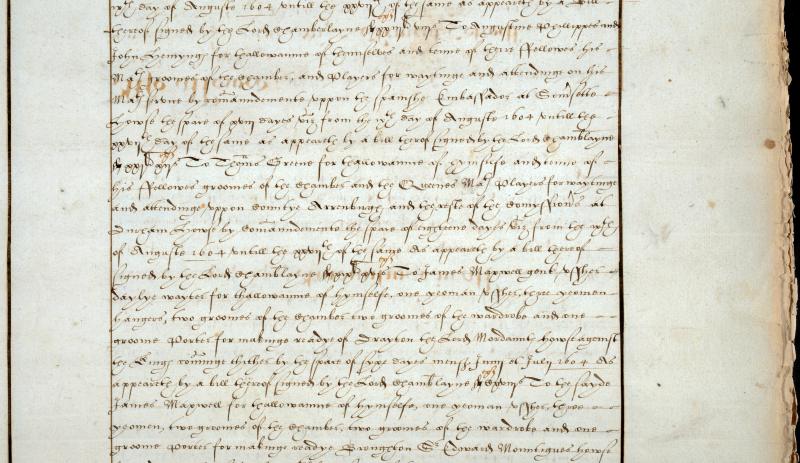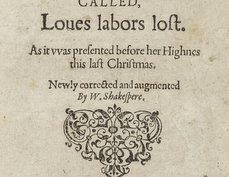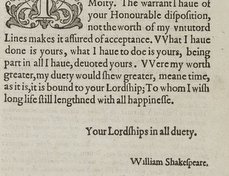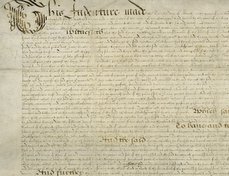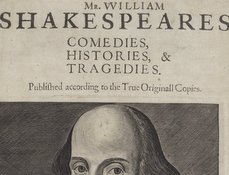Images reproduced by permission of The National Archives, London, England.
Terms of use
The National Archives give no warranty as to the accuracy, completeness or fitness for the purpose of the information provided.
Images may be used only for purposes of research, private study or education. Applications for any other use should be made to The National Archives Image Library, Kew, Richmond, Surrey TW9 4DU, Tel: 020 8392 5225 Fax: 020 8392 5266.
Document-specific information
Date: August 9-27, 1604
Repository: The National Archives, Kew, UK
Call number and opening: AO 1/388/41
View online bibliographic record
Alan H. Nelson, "Audit Office, Declared Accounts, Treasurer of the Chamber recording the King’s Men as attending on the Spanish ambassador," Shakespeare Documented, https://doi.org/10.37078/363.
The National Archives, AO 1/388/41. See Shakespeare Documented, https://doi.org/10.37078/363.
From August 9 to 26, 1604, twelve fellows of Shakespeare’s company, the King’s Men, attended upon the Spanish Ambassador at Somerset House, London. For about the same time, eleven fellows of the Queen’s Men attended upon other noblemen at Durham House, London:
... To Augustine Phillippes and John Hemynges for thallowaunce of themselves and tenne of their ffellowes his Maiesties groomes of the chamber, and Players for waytinge and attendinge on his Maiesties service by commaundemente vppon the spanishe Embassador at Somersette Howse the space of xviij dayes viz from the ixth day of Auguste 1604 vntill the xxvith day of the same as appeareth by a bill thereof signed by the Lord Chamberleyne xxjli xijs
To Thomas Greene for thallowaunce of himselfe and tenne of his Fellowes groomes of the Chamber and the Queenes Players for Wayting and attending vppon County Arrenbirgh and the rest of the Commyssioners at Durham Howse by Comaundemente the space of eighteene Dayes viz from the ixth of August 1604 vntill the xxvijth of th same As appeareth by a bill thereof signed by the Lord Chamberleyne xixli xvjs …
Identified as grooms of the chamber and also players, all are reimbursed at 2s per day. As both groups started on August 9 and served for eighteen days, attendance of the second group may have ended on August 26, like the first, rather than on August 27, as recorded. Though the treaty is dated August 28, it may have been signed earlier, as one of the visiting ambassadors is known to have departed on the 27th.
The eighteen days specified in the account entries represent the conclusion of The Treaty of London, “one of the most significant treaties in British history” (Croft, p. 18). The talks, which began on May 30, brought an end to hostilities between England and Spain which began in 1585 and included the battle of the Spanish Armada (1588). The chief negotiators are enshrined in a group portrait depicting three representatives each from Spain and the Spanish Netherlands, and five from England, including Charles Howard, Lord Admiral, and Robert Cecil, Secretary of State to James I of England. One copy of the group portrait, The Somerset House Conference, survives in the National Portrait Gallery, London , another in the National Maritime Museum, Greenwich.
As in most years since 1596-7, John Heminges accepted money from the royal treasury on behalf of the King’s Men, this time backed by Augustine Phillips. That William Shakespeare was one of their ten unnamed “ffellowes” may be inferred from contemporary rosters of the company, including the Lord Chamberlain’s distribution of red cloth just prior to March 15, 1604, and Augustine Phillips’s will, dated May 4, 1605. This is the only known record to identify Shakespeare (by inference) as a groom of the royal chamber.
To learn more, read Alan H. Nelson's essay on the use of "Fellow" as a title in Shakespeare's England.
Written by Alan H. Nelson
Sources
Pauline Croft, “England and the Peace with Spain, 1604,” History Review 49 (2004), 18-23.
Chris Laoutaris, Shakespeare and the Countess: The Battle that Gave Birth to the Globe (London: Fig Tree, 2014), 396-7.
B. Rowland Lewis, The Shakespeare Documents: Facsimiles, Transliterations, Translations and Commentary, vols. 1-2, (Stanford University, California: Stanford University Press, 1940), 2:372-3.
Samuel Schoenbaum, William Shakespeare: A Documentary Life (New York: Oxford University Press, 1975), 197, 199.
William Streitberger, ed., “Dramatic Records in the Declared Accounts of the Treasurer of the Chamber 1558-1642,” Malone Society Collections, vi (1977), 38.
David Thomas, Shakespeare in the Public Records (London: H.M.S.O., 1985), 15.
Last updated February 1, 2020

